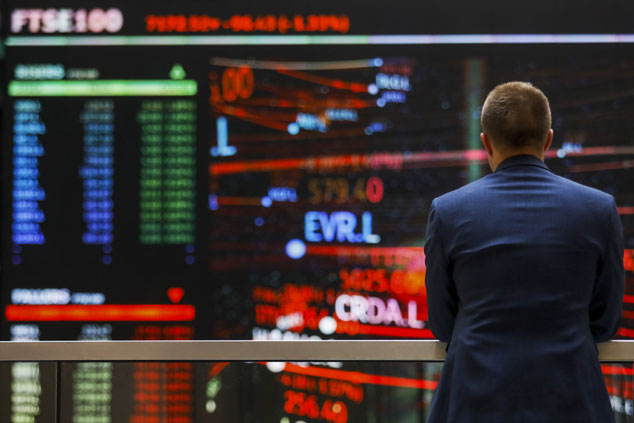
So you shouldn’t buy them. That’s hard to argue with. And it is why strategy group GMO’s latest estimate of the probable seven-year returns from stocks is profoundly gloomy: they reckon you will see a negative 3.8% return from large US stocks and a negative 1% return from small US stocks.
Go global and you might see a small positive return. But GMO predicts that you would have to put much of your money into risky emerging-market value stocks if you want to see anything that comes close to the long-term average real return from US stocks of 6.5%.
Negative interest rates are becoming the norm
It all seems very straightforward – but it isn’t. That is because the world’s most bizarre financial experiment ever, negative interest rates, continues. The European Central Bank currently charges banks minus 0.4% on their deposits. The Swiss National Bank is even more out there, with minus 0.75%.
Negative interest rates are becoming the norm for institutional deposits – having to see cash on hand as a cost has taken a bit of getting used to, but now passes almost uncommented on in board meetings. The same could be on the way for retail deposits.
UBS is introducing a negative rate on large deposits and rivals are likely to follow. Yields on German government bonds are negative across all timeframes. The ten-year UK gilt yield is now below 0.5% for the first time ever. US ten-year yields are not negative, but they are at an all-time low. In total, $16trn worth of government bonds now actively eat your money if you hold them to maturity.
Expect more of the same. Most analysts forecast monetary loosening in the US and the EU in September. Albert Edwards of Société Générale (one of the first to predict all this) says we could consider this to be a massive bond market bubble messing with our sanity. One could also argue that it is entirely normal: why shouldn’t investors pay to have cash stored? They already do so for stocks, classic cars, and art, for example.
Perhaps, as former US Federal Reserve chair Alan Greenspan put it this month: “Zero has no meaning.” Or you could see it as something more terrifying; “an appropriate reaction” to the fact that the next recession will quickly turn into a global deflationary bust. That would require a mix of extreme fiscal policy and “helicopter money”, driving rates down even further.
Don’t be distracted by the current round of political hysteria
All this monetary drama can be easily overshadowed by the general political hysteria around the world. The latter is important, of course. The final stage of the Brexit battle matters to the UK: Boris Johnson and Leavers have (just) the upper hand, but hardcore Remainers have done a remarkably good job of foiling the result of the referendum so far. The vote to quit the EU was three years ago; it still hasn’t happened.
We still cannot be sure what to expect, and that affects the economy in the short term. You can attribute the 0.5% rise in UK GDP in the first quarter and the 0.2% fall in the second to feverish preparations for the previous 29 March deadline for Britain to leave the EU.
The on-off nature of the US trade war with China (soon perhaps to be cold war) obviously makes a difference, too. A round of “reshoring” – returning manufacturing to the US – and other activity could conceivably be good for the US in the long term. The transition period might not be.
But these are political events, the likes of which developed countries with sound institutions have seen – and seen off – before. Negative interest rates are different.
Paper money has been around for about 1,000 years. No one has, as far as we know, ever offered negative interest rates on it before. In theory, that makes it the first thing investors should be thinking about. In practice, it also makes it impossible to have any sense of certainty about what to do.
It might mean you should start looking to buy a nice safe: if it costs you to keep your money in the bank, why not save yourself a bit of cash and keep it at home? It might mean that you should buy bond funds. Central banks may be thinking, as the US Federal Reserve’s Jay Powell suggested this week, about “whether we should expand our toolkit”. In a world overladen with debt and ageing populations, that means yields are going to keep falling and bond prices will rise – at least until inflation is finally unleashed.
It might also mean that you should keep piling into equities – any old equities. If stocks are the only asset class offering reliable and often rising income then maybe they remain the best asset class there is. There may be some real value around if you ignore the US and much-hyped tech stocks; look for the many equity funds on offer (in the UK at least) yielding 4%-5%.
However, the key thing to hold on to in our era of surprises is doubt. Too many investors (and definitely too many Twitter users) have an unwarranted level of certainty about too many things. They shouldn’t. Anyone who really thinks they can forecast what will happen over the next year – let alone the next decade – in this new negative-yield world, is likely to end up disappointed.
• This article was first published in the Financial Times